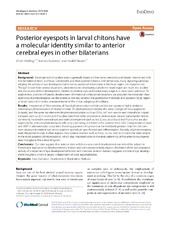| dc.description.abstract | Background: Development of cerebral eyes is generally based on fine-tuned networks and closely intertwined with the formation of brain and head. Consistently and best studied in insects and vertebrates, many signaling pathways relaying the activity of eye developmental factors to positional information in the head region are characterized. Though known from several organisms, photoreceptors developing outside the head region are much less studied and the course of their development, relation to cerebral eyes and evolutionary origin is in most cases unknown. To explore how position influences development of otherwise similar photoreceptors, we analyzed the molecular characteristics of photoreceptors we discovered at the very anterior, the posttrochal mid-body and posterior body region of larval Leptochiton asellus, a representative of the chiton subgroup of mollusks. Results: Irrespective of their position, all found photoreceptors exhibit a molecular signature highly similar to cerebral eye photoreceptors of related animals. All photoreceptors employ the same subtype of visual pigments (r-opsin), and the same key elements for phototransduction such as GNAq, trpC and arrestin and intracellular r-opsin transport such as rip11 and myosinV as described from other protostome cerebral eyes. Several transcription factors commonly involved in cerebral eye and brain development such as six1/2, eya, dachshund, lhx2/9 and prox are also expressed by all found photoreceptor cells, only pax6 being restricted to the anterior most cells. Coexpression of pax6 and MITF in photoreceptor-associated shielding pigment cells present at the mid-body position matches the common situation in cerebral eye retinal pigment epithelium specification and differentiation. Notably, all photoreceptors, even the posterior ones, further express clear anterior markers such as foxq2, irx, otx, and six3/6 (only the latter absent in the most posterior photoreceptors), which play important roles in the early patterning of the anterior neurogenic area throughout the animal kingdom. Conclusions: Our data suggest that anterior eyes with brain-associated development can indeed be subject to heterotopic replication to developmentally distinct and even posterior body regions. Retention of the transcriptional activity of a broad set of eye developmental factors and common anterior markers suggests a mode of eye development induction, which is largely independent of body regionalization. | en_US |

